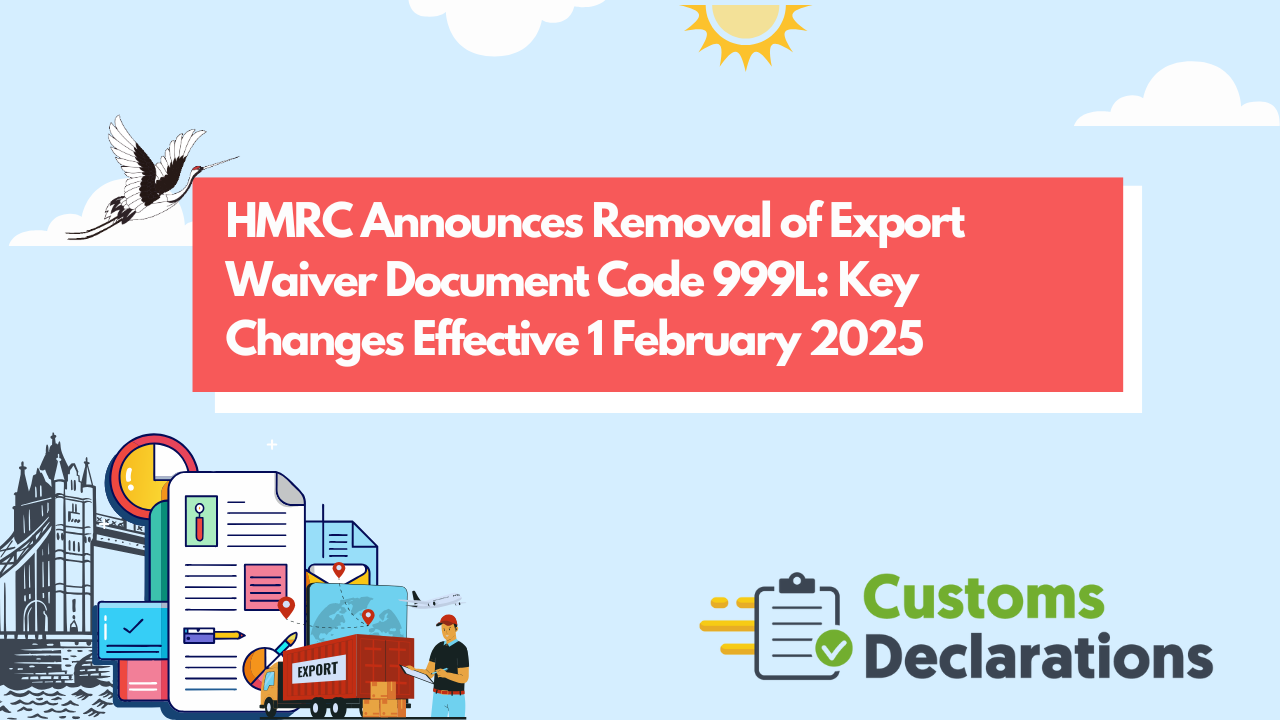In a significant update, HM Revenue and Customs (HMRC) has announced the forthcoming removal of the export waiver document code 999L, effective from 1 February 2025. This change is part of the transition from the Customs Handling of Import and Export Freight (CHIEF) system to the Customs Declaration Service (CDS), aiming to streamline and modernize the UK’s customs processes.
Background on Document Code 999L
The 999L code has been a temporary measure allowing declarants to claim waivers on certain export declarations. Initially set for removal earlier, its use was extended until 31 January 2025 to facilitate a smoother migration from CHIEF to CDS. Alongside 999L, document code Y999, which operates similarly, will also be withdrawn from most tariff measures on the same date.
Upcoming Changes Effective 1 February 2025
From 1 February 2025, the following changes will take effect:
- Invalidation of Codes 999L and Y999: Both codes will no longer be valid for export declarations.
- Introduction of Alternative Waiver Document Codes: Declarants must use specific waiver document codes corresponding to their commodity codes. These can be found in the UK Integrated Online Tariff by setting the ‘Date of Trade’ to 1 February 2025. While many existing codes will continue, some will be extended to cover exports, and new codes have been created to replace 999L.
Actions Required for Declarants
To ensure compliance with the new requirements, declarants should:
- Review Commodity Codes: Identify the applicable waiver document codes for your goods by consulting the UK Integrated Online Tariff with the ‘Date of Trade’ set to 1 February 2025.
- Transition to New Codes:
- Immediate Transition: For commodity codes with existing waiver document codes, you can cease using 999L/Y999 before 31 January 2025 by incorporating the necessary waiver document codes.
- Continued Use Until January: For commodity codes where new waiver document codes will apply from 1 February 2025, continue using 999L/Y999 for declarations arrived during January.
- Declarations Spanning January and February: If submitting an export declaration in January that may arrive in February and includes 999L or Y999, also include the waiver document code effective from 1 February 2025. Failure to do so will necessitate amending the declaration before its arrival in February to avoid rejection and the need for a replacement declaration.
- Supplementary Declarations: For exports arrived on or before 31 January 2025, use 999L or Y999, as these will be validated against the tariff measures applicable on the acceptance date.
Important Considerations
Before utilizing any waiver document code, ensure that your consignment meets the conditions for claiming the waiver. This due diligence is crucial to maintain compliance and avoid potential penalties.
Specific Export Licence Measures
HMRC has provided detailed guidance for specific export licence measures, including cultural goods, drugs export licences, radioactive sources, firearms, dual-use goods, military goods, and torture goods. Each category has designated waiver document codes that will become effective from 1 February 2025. Declarants should consult the relevant sections in the UK Integrated Online Tariff to identify and apply the appropriate codes.
Future Blocking of Document Status Codes XW and XX
HMRC plans to remove the use of document status codes XW and XX from document codes with available waiver document codes. This change aims to prevent issues such as multiple decrementing of a licence when one export licence is required against multiple document codes for a single item. HMRC is exploring solutions to resolve these issues and will provide advance notice before implementing these changes.
Conclusion
The removal of document codes 999L and Y999 marks a significant step in the UK’s transition to the Customs Declaration Service. Declarants must proactively adapt to these changes by familiarizing themselves with the new waiver document codes and adjusting their processes accordingly. Staying informed and prepared will ensure a seamless transition and continued compliance with HMRC regulations.
For detailed information and updates, refer to the official HMRC guidance on Data Element 2/3 Documents and Other Reference Codes (National) of the Customs Declaration Service (CDS).

